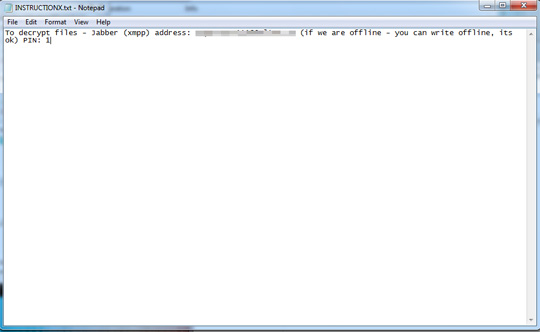Ransom.Win32.FLKR.THGAAAH
Windows


Threat Type: Ransomware
Destructiveness: No
Encrypted:
In the wild: Yes
OVERVIEW
Downloaded from the Internet, Dropped by other malware
This Ransomware arrives on a system as a file dropped by other malware or as a file downloaded unknowingly by users when visiting malicious sites.
TECHNICAL DETAILS
39,936 bytes
EXE
UPX
Yes
01 Jul 2019
Infects fixed and remote drives
Arrival Details
This Ransomware arrives on a system as a file dropped by other malware or as a file downloaded unknowingly by users when visiting malicious sites.
Installation
This Ransomware leaves text files that serve as ransom notes containing the following:
- INSTRUCTIONX.txt

File Infection
This Ransomware avoids infecting the following file types:
- avi
- mp3
- txt
Other Details
This Ransomware does the following:
- Clears Event Logs
- Application
- Security
- System
- Kaspersky Event Log
- Doctor Web
- Symantec Endpoint Protection Client
- Infects Fixed and Remote Drives
- Checks for a text file named fuckyou.txt in the same directory to proceed to it's ransomware routine. It also deletes the said text file after.
Ransomware Routine
This Ransomware avoids encrypting files found in the following folders:
- Windows
- Program Files
- Program Files(x86)
- System Volume Information
- Documents and Settings
- Users
- intel
- adfs
- cpqsystem
It appends the following extension to the file name of the encrypted files:
- {BLOCKED}user111@0nl1ne.at
SOLUTION
9.850
15.208.03
01 Jul 2019
15.209.00
02 Jul 2019
Step 1
Before doing any scans, Windows 7, Windows 8, Windows 8.1, and Windows 10 users must disable System Restore to allow full scanning of their computers.
Step 2
Note that not all files, folders, and registry keys and entries are installed on your computer during this malware's/spyware's/grayware's execution. This may be due to incomplete installation or other operating system conditions. If you do not find the same files/folders/registry information, please proceed to the next step.
Step 3
Identify and terminate files detected as Ransom.Win32.FLKR.THGAAAH
- Windows Task Manager may not display all running processes. In this case, please use a third-party process viewer, preferably Process Explorer, to terminate the malware/grayware/spyware file. You may download the said tool here.
- If the detected file is displayed in either Windows Task Manager or Process Explorer but you cannot delete it, restart your computer in safe mode. To do this, refer to this link for the complete steps.
- If the detected file is not displayed in either Windows Task Manager or Process Explorer, continue doing the next steps.
Step 4
Scan your computer with your Trend Micro product to delete files detected as Ransom.Win32.FLKR.THGAAAH. If the detected files have already been cleaned, deleted, or quarantined by your Trend Micro product, no further step is required. You may opt to simply delete the quarantined files. Please check the following Trend Micro Support pages for more information:
Step 5
Restore encrypted files from backup.
Did this description help? Tell us how we did.

